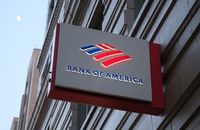Bank of America has been ordered to pay $540.3 million to the Federal Deposit Insurance Corporation (FDIC) due to underpaid deposit insurance premiums, marking a significant legal resolution for the bank. This ruling comes just hours before the bank's anticipated first-quarter earnings report, which is set to reveal its financial performance amid a challenging economic landscape.
The legal dispute, which dates back to 2017, centers on Bank of America's failure to properly report counterparty risk as mandated by a 2011 rule established following the 2008 financial crisis. The FDIC argued that the bank's misreporting led to an understatement of its risk profile, resulting in lower payments to the Deposit Insurance Fund. Although the court dismissed Bank of America's claims that the 2011 rule was unreasonable, it ruled that the FDIC's lawsuit was filed too late to claim underpayments prior to the second quarter of 2013. The $540.3 million payment covers the period from Q2 2013 to the end of 2014, significantly less than the FDIC's initial claims, which exceeded $1 billion.
Despite the hefty penalty, Bank of America has already set aside funds to cover the ruling and expressed relief that the long-standing dispute has been resolved. The bank's stock, however, has seen a decline of 17% this year through April 14, 2025, prompting investors to closely monitor the upcoming earnings report.
Wall Street analysts maintain a largely positive outlook on Bank of America, with a "Strong Buy" consensus rating based on 15 Buys and three Holds assigned in the last three months. The average price target for Bank of America shares stands at $50.97, indicating a potential upside of 39% from current levels. Analysts expect the bank to report earnings per share of $0.82, up from $0.76 in the same period last year, with revenue projected to rise more than 4% to $26.97 billion.
Bank of America is expected to report a net interest income of $14.49 billion, an increase from $14 billion in Q1 2024. The bank had previously guided for net interest income to be between $14.5 billion and $14.6 billion for the first quarter on a fully taxable equivalent basis. Furthermore, the bank anticipates this figure to increase to between $15.5 billion and $15.7 billion by the fourth quarter of 2025.
Trading revenue is another area of focus for the bank. Analysts predict that the volatility in the first quarter will have boosted trading revenues, especially following President Trump's tariff announcements that affected market stability. This trend has already been observed at Goldman Sachs, which reported a 15% jump in profit driven by strong trading performance.
In addition to the penalty, Bank of America is also facing scrutiny over its trading results. The company has reported that its stock traders achieved a record quarter, with revenue from equity trading rising 17% to $2.18 billion in the first three months of the year. This uptick in trading revenue has been attributed to the increased market volatility and higher client activity.
Bank of America’s net interest income rose to $14.6 billion in the first quarter, exceeding the $14.56 billion estimate from analysts. The bank's CEO, Brian Moynihan, noted, "Our business clients have been performing well; and consumers have shown resilience, continuing to spend and maintaining healthy credit quality." He emphasized that the disciplined investments made for high-quality growth and the bank's diverse set of businesses would continue to be a source of strength, despite potential economic changes.
The bank's provision for loan losses came in at $1.5 billion, which was better than the $1.58 billion estimate, indicating that the bank is preparing for potential economic downturns. This provision is a key metric that investors monitor closely as it reflects the bank's expectations regarding loan defaults.
As shareholders await the earnings report, they are keen to hear how Bank of America plans to navigate the ongoing economic uncertainties and the implications of the current trade policies on its operations. The results from other major banks, such as Citigroup, which also reports earnings today, will provide further context for investors assessing the banking sector's performance in the current climate.
In summary, while the $540.3 million penalty from the FDIC presents a challenge for Bank of America, the bank's strong trading performance and positive earnings expectations may help bolster investor confidence. As the financial landscape continues to evolve, Bank of America’s ability to adapt and thrive will be closely scrutinized by market analysts and shareholders alike.







